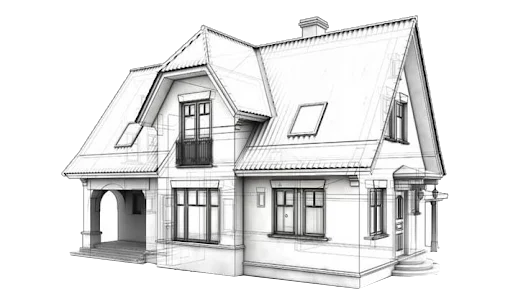
Frequently Asked Questions
These are just a few of the common questions we get asked. For more personalized information, give us a call!

Frequently Asked Questions (FAQs)
3D Building Mapping
What are the benefits of using 3D building mapping for residential home inspection?
Some of the main benefits of using 3D building mapping for residential home inspection include:
- More accurate assessments: 3D building mapping provides highly detailed data about a home’s structure, allowing inspectors to identify potential issues that might be missed during a visual inspection.
- More efficient inspections: By using 3D building mapping, inspectors can conduct more thorough inspections in less time, which can save homeowners money and reduce the time it takes to complete the inspection process.
- Better communication with homeowners: 3D building mapping can help inspectors communicate potential issues with homeowners more clearly by providing visual representations of the issues.
How can 3D building mapping be used in residential home inspection?
3D building mapping can be a valuable tool for residential home inspectors because it allows them to conduct more detailed and accurate inspections. By creating a 3D model of a home, inspectors can identify potential issues that might not be immediately apparent during a visual inspection. For example, they can use the model to detect areas where insulation might be lacking, or to identify areas of the home where moisture might be collecting.
What is 3D building mapping?
3D building mapping is the process of creating a digital representation of a physical structure. It involves using specialized software and hardware to capture detailed measurements and images of a building’s exterior and interior, and then using that data to create a highly accurate 3D model of the structure.
Sewer
What if the sewer line is located underneath the house?
If the sewer line is located underneath the house, the inspector may need to access the line through a cleanout or by removing a toilet.
What happens if the sewer scope inspection reveals issues?
If the sewer scope inspection reveals issues, you can negotiate with the seller to have them fixed before closing or adjust the purchase price to account for the necessary repairs.
Why is sewer scoping important?
Sewer scoping is important in a residential home inspection because it can reveal hidden issues that can be expensive to repair, such as clogs, tree root intrusion, or damaged pipes.
What is sewer scoping?
Sewer scoping is a process that involves inspecting the inside of a residential sewer line with a specialized camera to identify any potential problems or defects.
Water
What should I do if the results of my water test indicate that my water is contaminated?
If the results of your water test indicate that your water is contaminated, you should take immediate steps to address the issue. This may include installing a water filtration system, replacing aging infrastructure, or working with your local water utility to address the problem.
What are the different types of water tests available?
There are several different types of water tests available for residential homes, including tests for bacteria, lead, arsenic, nitrates, and pesticides. Your water testing professional can help you determine which tests are necessary based on your specific needs and concerns.
What are the most common contaminants found in residential water?
The most common contaminants found in residential water include bacteria, viruses, lead, arsenic, nitrates, and pesticides. These contaminants can enter the water supply through a variety of sources, including agricultural runoff, industrial waste, and aging infrastructure.
What is water testing for residential homes?
Water testing for residential homes is the process of analyzing the quality of water in a house to determine if it is safe for consumption. This is important to ensure the health and safety of those living in the home.
Water testing is necessary for residential homes because it helps to identify any contaminants or impurities that may be present in the water supply. These contaminants can be harmful to human health and may cause a variety of health issues if left unchecked.
Radon
What should I do if my home has high levels of radon?
If your home has high levels of radon, you should take steps to reduce your exposure to the gas. This can be done by installing a radon mitigation system, which uses ventilation techniques to redirect the gas from your home. You should also seal any cracks or openings in your home’s foundation to prevent radon from entering.
How often should I test my home for radon?
The EPA recommends that homeowners test their homes for radon at least once every two years, even if previous tests have shown low levels of radon. Testing is especially important if you have made structural changes to your home, such as adding a basement or altering the foundation.
What is radon, and why is it a concern for homeowners?
Radon is a colorless, odorless, and tasteless gas that is formed by the natural breakdown of uranium in soil, rock, and water. It can seep into homes and buildings through cracks and other openings in the foundation, and long-term exposure to elevated levels of radon can increase the risk of lung cancer.
Mold
What happens if mold is found during the inspection?
If mold is found during the inspection, the inspector will provide a detailed report outlining the type, extent, and location of the mold growth. They may also provide recommendations for remediation, which may include cleaning and removal of the mold growth, as well as addressing any underlying moisture issues.
What does a mold inspection involve?
A mold inspection typically involves a visual inspection of the property, air and surface sampling for mold spores, and analysis of the collected samples in a laboratory. The inspector may also use moisture meters and infrared cameras to detect hidden mold growth.
How do I know if I need a mold inspection?
You may need a mold inspection if you have noticed a musty odor, have experienced allergic symptoms, have had water damage or flooding, or if you have visible mold growth.
What is a mold inspection?
A mold inspection is an assessment of a building or property to identify any existing or potential mold growth. It involves a visual inspection of the property, testing of the air and surfaces for mold spores, and analysis of the collected samples in a laboratory.
Lead
What happens if lead is found in my home?
If lead is found in your home, it’s important to take steps to address the issue as soon as possible. Depending on the severity of the contamination, this may involve removing or encapsulating the affected materials, such as paint or soil, or taking steps to prevent exposure to contaminated water. A professional lead abatement specialist can provide guidance on the best course of action.
When should I have my home tested for lead?
If you have an older home (built before 1978), it’s a good idea to have it tested for lead. Additionally, if you have young children or pregnant women living in the home, it’s especially important to have it tested. You may also want to have your home tested if you’re planning to do any renovations or repairs that may disturb paint or other materials that may contain lead.
Why is lead testing important?
Lead testing is important because it helps to identify the presence of lead in a home, which can help prevent exposure to this toxic substance. Exposure to lead can cause a range of health problems, including developmental delays, learning disabilities, and even death in severe cases.
What is lead testing?
Lead testing is a process of testing the presence of lead in various components of a property, such as the paint, soil, and water. Lead is a toxic substance that can cause serious health problems, especially in children and pregnant women.
Asbestos
Is it safe to live or work in a building with asbestos?
Asbestos is only dangerous when it is disturbed and fibers are released into the air. If asbestos-containing materials are in good condition and not likely to be disturbed, it may be safe to continue living or working in the building. However, it is important to have regular inspections to monitor the condition of the asbestos and take appropriate action if needed.
What happens if asbestos is found during an inspection?
If asbestos is found during an inspection, the inspector will provide recommendations for how to manage or remove the asbestos-containing materials. Depending on the extent and condition of the asbestos, removal may be necessary to protect the health of building occupants.
How is asbestos inspection done?
Asbestos inspection typically involves a visual inspection of the building and sampling of suspect materials. A certified asbestos inspector will take samples of materials that are likely to contain asbestos and send them to a laboratory for testing. The laboratory will then report back to the inspector with the results.
What is asbestos inspection, and why do I need it?
Asbestos inspection is the process of identifying the presence and condition of asbestos-containing materials in a building. You may need an asbestos inspection if you are planning to renovate or demolish a building, or if you suspect that asbestos may be present due to the age and condition of the building.
What is asbestos, and why is it dangerous?
Asbestos is a naturally occurring mineral that was widely used in building materials until the 1980s. When asbestos fibers are inhaled, they can become lodged in the lungs and cause a range of health problems, including lung cancer, mesothelioma, and asbestosis.
Home Inspection
Should I be present for the inspection?
Yes, you should definitely be present for the inspection of your potential home. Attending the inspection can provide you with valuable information about the condition of the property and help you make informed decisions about your investment. By being present during the inspection, you can ask the inspector questions as they arise and get a better understanding of the home’s overall condition.
Moreover, accompanying the inspector throughout the inspection will allow you to learn about the maintenance of the home, its systems, and components. This information can be helpful in the long run, especially in the case of necessary repairs or future upgrades. Additionally, being present during the inspection will give you an opportunity to see any potential defects or issues firsthand.
It’s important to note that not all inspectors may allow you to attend the inspection. In such a case, you should consider hiring a different inspector who does allow your presence during the inspection. Many homebuyers find the inspection process to be a valuable and worthwhile experience that helps them make informed decisions about their investment. Therefore, attending the inspection is highly recommended to gain insight into the home’s potential sale points and defects.
At what point in the real estate transaction should I schedule a home inspection?
Typically, scheduling a home inspection is an essential step in the real estate buying process. As a home buyer, you’ll want to have an inspection done before you finalize the purchase to ensure that the property is in good condition and doesn’t require any costly repairs or renovations. So, at what point in the real estate transaction should you schedule a home inspection?
The best time to schedule a home inspection is after your offer has been accepted but before the closing date. This allows the inspector to examine the property thoroughly and identify any significant issues that may affect the value or safety of the property. Scheduling the inspection at this stage also gives you the opportunity to renegotiate the terms of the sale or walk away from the deal altogether if the inspection uncovers major issues.
In some cases, it may not be possible to schedule the inspection before the closing date due to contractual or timing issues. If this happens, it’s essential to schedule the inspection as soon as possible after the closing date. Delays in scheduling the inspection can lead to missed deadlines and potential problems with the seller, so it’s critical to prioritize the inspection and ensure that it’s done as soon as possible.
In summary, scheduling a home inspection is a crucial part of the real estate buying process. It’s best to schedule the inspection after your offer has been accepted but before the closing date. However, if this isn’t possible, be sure to schedule the inspection as soon as possible after the closing date to avoid any delays or issues.
Why should I get a home inspection?
Getting a home inspection is crucial when buying a home, as it can provide you with valuable information that you may not have been able to observe yourself. A professional home inspector can examine the property thoroughly and identify any potential issues, ranging from minor cosmetic concerns to major structural damage or health and safety hazards.
By uncovering defects in the home, a home inspection can help you avoid unexpected expenses after you move in, allowing you to negotiate with the seller for repairs or a lower sale price. It can also give you peace of mind knowing that you are making an informed decision about your investment.
Furthermore, many mortgage lenders require a home inspection before approving a loan, so getting one may be necessary to secure financing for your home purchase.
Overall, a home inspection is a wise investment for any homebuyer, providing valuable insight into the condition of the property and helping to ensure that you are making an informed decision about your purchase.
What does a home inspection include?
A standard home inspection will cover various aspects of the home’s systems and structure, including:
- Heating system: The inspector will check the heating system to ensure that it is in good working order. This includes examining the furnace, boiler, or heat pump, as well as the ductwork, chimneys, and vents.
- Central air conditioning system: The inspector will also examine the central air conditioning system, if present and if the temperature permits, to ensure that it is functioning correctly.
- Interior plumbing system: The inspector will examine the home’s interior plumbing system, including the pipes, fixtures, and water heater, to ensure that everything is in good working order.
- Electrical system: The inspector will examine the electrical system, including the wiring, outlets, and switches, to ensure that everything is up to code and in good working order.
- Roof, attic, and visible insulation: The inspector will examine the roof, attic, and visible insulation to ensure that there are no leaks, water damage, or other issues that could cause problems.
- Walls, ceilings, floors, windows, and doors: The inspector will examine the walls, ceilings, floors, windows, and doors to ensure that they are in good condition and functioning correctly.
- Foundation, basement, and structural components: The inspector will examine the foundation, basement, and other structural components of the home to ensure that they are sound and free from defects.
It’s important to note that there may be some exceptions to what the inspector can assess. For example, if certain areas are inaccessible due to locked doors or tenant’s belongings in the way, the inspector will explain the situation and note that they could not assess that specific area or system. Additionally, if there are unsafe conditions such as severely steep roofs or poor structural integrity, the inspector will note the issue and provide recommendations for repairs or further evaluation. The American Society of Home Inspectors (ASHI) publishes a Standard of Practice and Code of Ethics that outlines what to expect in a home inspection report.
What is a home inspection?
A home inspection is a comprehensive evaluation of the physical condition of a property, usually performed by a certified home inspector, that includes examining the major systems and components of a home such as the foundation, roof, electrical, plumbing, and heating/cooling systems. The purpose of a home inspection is to identify any potential safety hazards, defects, or deficiencies that may affect the home’s functionality, safety, and livability. A home inspector is expected to adhere to a set of standards of practice that outline what should be included in a general home inspection, which may vary depending on the location and type of property being inspected.
During a home inspection, the inspector will visually examine the home’s components and systems that are safely accessible, and may use specialized equipment such as a moisture meter, infrared camera, or gas leak detector to identify hidden defects or potential problems. The inspection usually takes several hours, depending on the size, age, and complexity of the home.
After the inspection, the inspector will provide the client with a written report detailing their findings, often including photographs and recommendations for any necessary repairs or improvements. The report may also include a summary of the home’s condition and an estimate of the remaining life of the major systems and components.
It is important to note that a home inspection is not a guarantee of the home’s condition, nor is it a pass/fail evaluation. Rather, it is an objective assessment of the home’s current condition and the inspector’s professional opinion on the likelihood of future problems. The information provided by a home inspection can be valuable for buyers, sellers, and homeowners to make informed decisions about the property.
